
The Caprifoliaceae or honeysuckle family is a clade of dicotyledonous flowering plants consisting of about 860 species, in 33, to 42 genera, with a nearly cosmopolitan distribution. Centres of diversity are found in eastern North America and eastern Asia, while they are absent in tropical and southern Africa.
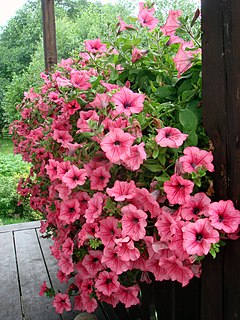
Ornamental plants or garden plants are plants that are grown for decorative purposes in gardens and landscape design projects. Many if not most are flowering plants, and garden varieties tend to be specially bred cultivars that improve on the original species in qualities such as colour, shape, scent and long-lasting blooms. There are many examples of fine ornamental plants that can provide height, privacy, and beauty for any garden. These ornamental perennial plants have seeds that allow them to reproduce. One of the beauties of ornamental grasses is that they are very versatile and low maintenance. All the main types of plant have many ornamental varieties: trees, shrubs, aquatic plants, perennial and annual plants. Non-botanical classifications include houseplants, bedding plants, plants for cut flowers and foliage plants. The cultivation of ornamental plants comes under floriculture and tree nurseries, which is a major branch of horticulture.

Tribulus is a genus of plants in the family Zygophyllaceae and found in diverse climates and soils worldwide from latitudes 35°S to 47°N. The best-known member is T. terrestris, a widespread invasive species and weed.

Microbiota is a monotypic genus of evergreen coniferous shrubs in the cypress family Cupressaceae, containing only one species, Microbiota decussata. The plant is native and endemic to a limited area of the Sikhote-Alin mountains in Primorskiy Krai in the Russian Far East. Microbiota is not to be confused with the range of microorganisms of the same name. The genus name was derived from micro-, meaning "small", + Biota, the genus name for a closely related conifer, a species formerly called Biota orientalis, now renamed Platycladus orientalis.

Pink ivory, also called purple ivory, red ivory, umnini or umgoloty, is an African hardwood used to make a variety of products. The pink ivory tree grows predominantly in Zimbabwe, Mozambique, Northern Botswana and South Africa. The tree is protected and sustainably maintained in South Africa, only felled by very limited permit. The wood is extremely hard, with a density of 990 g/dm3.

Watsonia is a genus of plants in the family Iridaceae, subfamily Crocoideae. Watsonias are native to southern Africa. The genus is named after Sir William Watson, an 18th-century British botanist.

Lampranthus is a genus of succulent plants in the family Aizoaceae, indigenous to southern Africa.

Dimorphotheca is a genus of plants in the family Asteraceae, native to Africa and Australia. is one of eight genera of the Calenduleae, with a centre of diversity in Southern Africa. Some species can hybridize with Osteospermum, and crosses are sold as cultivated ornamentals. The name "Dimorphotheca" comes from the Greek "Dis" "Morphe" and "Theka", meaning "two shaped receptacle", referring to the dimorphic cypselae, a trait inherent to members of the Calenduleae. Plants of this genus usually have bisexual flowers.

Philodendron hederaceum, the heartleaf philodendron is a species of flowering plant in the family Araceae, native to Central America and the Caribbean which is common in the houseplant trade. Philodendron hederaceum var. hederaceum, previously known as Philodendron micans, also known as the "velvet philodendron" is a subspecies which is also in the houseplant trade.

Oscularia deltoides, the deltoid-leaved dewplant, dassievygie or sandsteenvygie is a species of flowering succulent plant in the fig-marigold family Aizoaceae that is native to the south-western Cape, South Africa.

Berkheya is a genus of flowering plants in the aster family, Asteraceae, and the subfamily Carduoideae, the thistles. It is distributed in tropical Africa, especially in southern regions. Of about 75 species, 71 can be found in South Africa.
Drosera zeyheri is a species in the carnivorous plant genus Drosera that is endemic to the Cape Provinces of South Africa. Some botanists treat this species to be a form of D. cistiflora. It differs from typical D. cistiflora specimens by being smaller, sometimes having cauline leaves on the short stems with white, pink, or red flowers. Botanist Fernando Rivadavia has said that he believes of all the forms and varieties in the D. cistiflora complex, D. zeyheri could possibly merit distinction at the species rank. He found it easy to distinguish it from D. cistiflora by its mostly stemless habit, though it often does present one to three leaves on the flower scape. Drosera zeyheri was first described by Terence Macleane Salter in a 1940 volume of the Journal of South African Botany.

Oscularia is a genus of succulent flowering plants in the family Aizoaceae, native to semi-arid and rocky habitats in the Western Cape of South Africa.
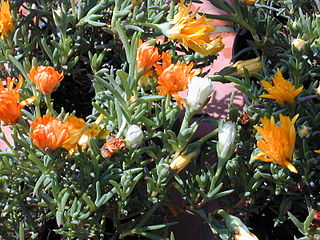
Lampranthus aurantiacus, the trailing iceplant, is a plant species in the genus Lampranthus native to South Africa and naturalized in gardens all around the world.
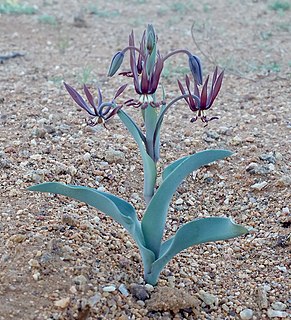
Ornithoglossum is a genus of plants native to southern Africa, some of which are widely cultivated as ornamentals. Nine species are currently recognized, as of April 2014:

Lampranthus glaucus is a plant species in the genus Lampranthus native to South Africa and naturalized in gardens all around the world.

Combretum zeyheri, the large-fruited bushwillow or Zeyher's bushwillow, is a species of flowering plant in the family Combretaceae, usually found growing on acidic or sandy soils in tropical African savannas. A small to medium-sized tree, its roots are used as a source of material for making baskets and as a traditional medicine for haemorrhoids.
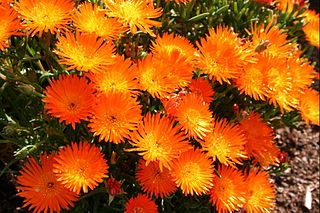
Lampranthus aureus is a species of shrub in the family Aizoaceae. They are succulent plants. They have a self-supporting growth form and simple, broad leaves.
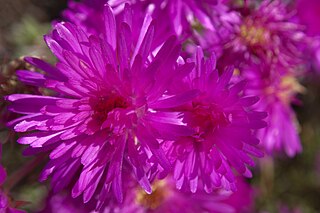
Lampranthus multiradiatus, the creeping redflush, is a species of shrub in the family Aizoaceae. They are succulent plants. They have a self-supporting growth form and simple, broad leaves.

Lampranthus spectabilis, the trailing iceplant, is a species of flowering plant in the family Aizoaceae, native to the Cape Provinces of South Africa. The unimproved species and a number of cultivars are commercially available, including 'Tresco Apricot', 'Tresco Brilliant', 'Tresco Fire', 'Tresco Orange', 'Tresco Peach', 'Tresco Pearl', 'Tresco Purple', and 'Tresco Red'.



















